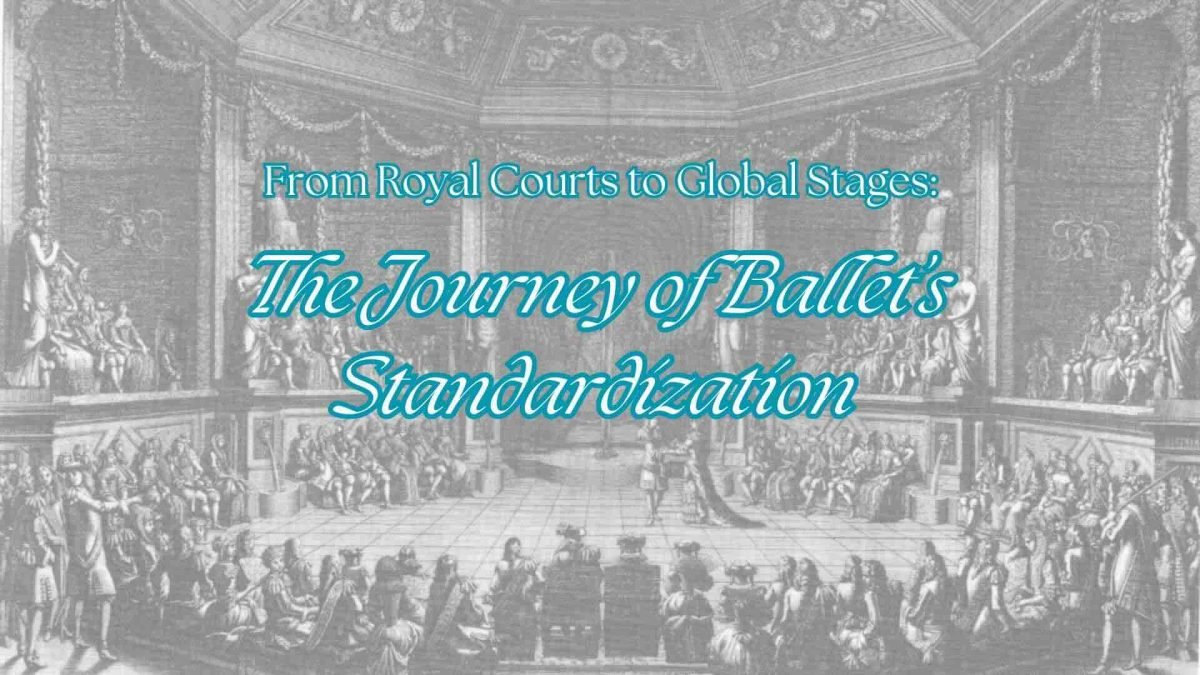By Neha Chowdhury from En Avant Magazine May June 2024
In the past, ballet was considered a form of entertainment; a pastime, something kings and queens watched for its beauty and their own enjoyment. Now, ballet is still a form of performing arts- but it has another side to its indomitable power; the side of examination, rule-following, and competitivity that surrounds becoming the best ballerina you can be.
 The standardization of ballet. Let’s begin by dissecting this statement. The word standardization refers to how ballet moved from being a non-structured art to conforming to a series of standards. That makes you wonder; what is this series of standards? Where did it come from? Who signed off on it? Where is it now? Couldn’t it have been less strict so I didn’t need to stress over ballet examinations? These are some questions you’ll be able to answer through this article.
The standardization of ballet. Let’s begin by dissecting this statement. The word standardization refers to how ballet moved from being a non-structured art to conforming to a series of standards. That makes you wonder; what is this series of standards? Where did it come from? Who signed off on it? Where is it now? Couldn’t it have been less strict so I didn’t need to stress over ballet examinations? These are some questions you’ll be able to answer through this article.
Let’s start from the dawn; by stepping into the shoes of a random person in the Renaissance courts of Italy. Not much is known about the very beginnings of ballet, but I would guess that this person must have one day looked at his pointed feet and said “How beautiful! Time to turn this into a worldwide art form.” Perhaps not, but that is certainly how it ended up. Ballet was performed as a spectacle during opulent events like weddings, grand soirees, balls, etc. In the 1500s, ballet was brought to France by the Italian noblewoman Catherine de Medici, who married French King Henry II and called for ballerinas to grace the stages of France. “I call for pointed feet and glittery skirts in the land of cheese and wine!” (you’ll have to trust me on this one, though I cannot give you definitive historical evidence).
 Approximately one hundred years later, those excellently pointed toes caught the eye of King Louis XIV, who was responsible for not just ballet as we know it today, but also the world-famous fashion industry of France and brands, including Chanel and Dior. Between the years 1643 and 1648, the country of France suffered through much political upheaval. This is known as La Fronde de La France, or the Sling of France. During this time, the French citizens were very defensive and tried to overthrow the government. In an effort to unite the country, King Louis decided to take the path into the people’s hearts. A patron of the arts, specifically dance, he decided to gain their trust by setting up ballet performances. I don’t know about you, but ballet would be a major contributing factor if I were to trust someone. In 1653, King Louis conjured up a 12-hour dance performance, from sundown to sunset. This was called Ballet de La Nuit, or the Ballet of the Night. The metaphorical idea behind this setup was that the darkness was the war and hardships France was facing, and the light (here meaning the savior at daybreak) was the King. This is where his nickname or moniker “Le Roi Soleil” or the Sun King comes from. This performance definitely touched the hearts of the French, because soon after King Louis made ballet the next big thing.
Approximately one hundred years later, those excellently pointed toes caught the eye of King Louis XIV, who was responsible for not just ballet as we know it today, but also the world-famous fashion industry of France and brands, including Chanel and Dior. Between the years 1643 and 1648, the country of France suffered through much political upheaval. This is known as La Fronde de La France, or the Sling of France. During this time, the French citizens were very defensive and tried to overthrow the government. In an effort to unite the country, King Louis decided to take the path into the people’s hearts. A patron of the arts, specifically dance, he decided to gain their trust by setting up ballet performances. I don’t know about you, but ballet would be a major contributing factor if I were to trust someone. In 1653, King Louis conjured up a 12-hour dance performance, from sundown to sunset. This was called Ballet de La Nuit, or the Ballet of the Night. The metaphorical idea behind this setup was that the darkness was the war and hardships France was facing, and the light (here meaning the savior at daybreak) was the King. This is where his nickname or moniker “Le Roi Soleil” or the Sun King comes from. This performance definitely touched the hearts of the French, because soon after King Louis made ballet the next big thing.
The First Ballet Academy
In 1661, the Académie Royale de Danse, the first ballet school in history, was founded. Let’s talk about why and how he brought about this standardization. The king had a childhood love for dance, and when the opportunity arose, he decided to elevate ballet from an activity done for fun to an artistic sport that required professional training, and following a set of rules. He transformed ballet into a high-class opportunity, meaning that only high-level members of the court, including educated noblemen and noblewomen could practice and perform it. Now you can say you perform the dance of the royals! The King saw the potential in ballet; he saw the diamond that could be cut from coal, and transformed it from a practice for amateurs to a disciplined art form that requires training. This was when King Louis, along with his dance instructor Pierre Beauchamp, created the five positions of ballet, and where the ballet we practice today began.
The French opera “Le Triomphe de l’Amour” integrated ballet elements, establishing a lasting opera-ballet tradition in France. By the mid-1700s, French ballet master Jean Georges Noverre opposed the artificiality of combining the two styles of opera and ballet, advocating for ballet as an art form in itself. He introduced ballet d’action, which emphasized expressive, dramatic movement to reveal character relationships, a manner of telling a story, setting the stage for 19th-century narrative ballets.
 The Romantic Movement
The Romantic Movement
In the 19th century, classical ballets, still famous today such as “Giselle” and “La Sylphide” emerged during the Romantic Movement, which influenced art, music, and dance; basically all realms of creative expression. Romantic ballets often depicted unearthly themes and saw the rise of pointe work for ballerinas, dancing on the tips of the toes, well-known today for making the world’s population awestruck at the wonders of ballet, as well as the introduction of the romantic tutu, a calf-length, sort of billowy tulle skirt.
Today, ballet is greatly associated with the phrase “classical dance”. One of the main reasons ballet became a standard, global classical dance style is because it was the first genre to be codified. Codification and standardization are basically synonyms; they both refer to formulating a system for something, in this case, ballet steps, movements, and variations. This helped teachers instruct their students with a fixed rulebook, a set of guidelines that couldn’t be misinterpreted. As previously stated, ballet steps all have French names. This is another aspect of ballet codification; a universal language for communication of dance. The French names were not just a result of their beginnings in France, rather, they were a reflection of the simplicity that follows having one way to refer to things. People all around the world could learn and teach ballet; whether they knew the native language of where they were located or not. Here’s a visual example. Ms. Ivanov has come from Russia to Spain to spread her ballet expertise. Her students are mostly Spanish; they have trouble understanding her Russian ballet steps. This issue is resolved quickly when Ms. Ivanov says “demi plie” or “sautés”- everyone knows what those are! Since French steps were widely known and associated with their movements, it was easy for ballet to become a baseline dance form rooted in history. In connection with this point is the next; ballet was popularised by influential people- the kings and queens of France, a dominant, strong country leading Europe, which made it easy for ballet to spread with the political power of its patrons.
Ballet as an Evolving Art
Finally, we come to the more modern side of ballet that makes it so universal; its ever-evolving nature. Some stereotypes portray ballet as a rigid, stuck-in-the-past style that doesn’t allow for exploration and creativity. This is definitely the wrong idea. Ballet is, and was, a type of dance that pushed the limits of the human body, calling for stronger, better, cooler, newer ways of moving to music. With each new generation of dancers, ballet evolves with the earth. This makes it a constant force in the world of dance, time-honoring its roots in Italy, France, and Russia, while at the same time continuously moving forward and growing, kind of like a banyan tree.
Now, at this point, we’ve come up to speed with the historical context surrounding ballet and its standardization. In today’s world, ballet has several different methods followed by dancers and dance companies around the world. Most of these are versions of Classical Ballet, tweaked to form different styles of generally the same syllabus (which includes steps like plies, port de bras, etc.). These different styles were introduced by what we call the legends of ballet; the living, breathing Greatest Of All Times. Some well-known examples include the French style, called the Modern Codified Technique – which formed the basis for all other styles, the Cecchetti method – the Italian style developed by Enrico Cecchetti, the Vaganova method – the Russian style known for its rigorous training and world-class dancers, developed by Agrippina Vaganova, and the Balanchine method – the American style developed by George Balanchine. The basic steps of ballet are common among all these styles; the main difference is how they are expressed. For example, the Vaganova technique is known for its high expressivity, while the Danish Bournonville technique focuses on ballon, or “the illusion of imponderable lightness.” Another common ground between the various methods is examination and testing. While exams aren’t entirely compulsory, they are a way of ensuring a student is ready to move on to the next grade.
The journey of ballet’s standardization is a fascinating tale of transformation from courtly entertainment to the highly disciplined and universal art form we know today. It all started in the lavish courts of Renaissance Italy, with key figures like Catherine de Medici and King Louis XIV who marked the turning point of ballet converting into a precise art form that demanded dedication and skill. Today, ballet is a global phenomenon, with different styles that reflect its rich history while allowing for individual expression. Whether it’s the expressive Vaganova method from Russia or the light, airy Bournonville technique from Denmark, all these styles share the same foundational steps. Examinations and testing might seem daunting, but they’re part of what keeps the tradition alive and thriving. Despite some stereotypes, ballet is anything but rigid. It’s a constantly evolving art form, pushing the limits of creativity and physical prowess with each new generation of dancers. Ballet’s blend of tradition and innovation ensures it remains a dynamic and captivating force in the world of dance. From its regal origins to its modern-day versatility, ballet’s standardized techniques and universal appeal continue to inspire and enchant. So to answer the questions we began with, no one person created ballet. Rather, it began with a passion, a dream for dance that, over the years, evolved and grew. Years have gone by, marked by centuries of culture and art, and yet, the human passion to move and express emotion through dance has always been a strong force in the world of performance.








Leave a Reply